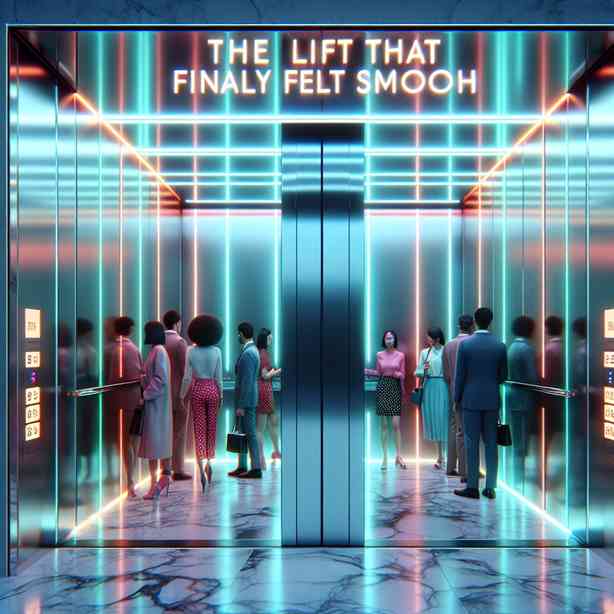
The Lift That Finally Felt Smooth
In our daily lives, we often overlook the convenience that elevators provide. They effortlessly transport us from one floor to another, saving us the energy of climbing countless stairs. Yet, how often do we stop to consider the mechanics behind this innovation? Today, we will delve into the world of elevators, focusing on the evolution of their technology, the importance of smooth operation, and how recent advancements have addressed some of the long-standing issues associated with these essential machines.
To begin, it is crucial to understand the simplicity and complexity intertwined in elevator systems. While the concept of an elevator may seem straightforward—transporting people and goods vertically—behind the scenes lies a sophisticated arrangement of pulleys, cables, and counterweights, all designed to ensure safety and efficiency. The history of elevators dates back to ancient times; however, it was not until the 19th century that elevators started becoming more common with the advent of steam power and later, electric motors.
One significant advancement in elevator technology was the invention of the electric elevator in the late 1800s. This breakthrough transformed not only how buildings were designed, allowing for the construction of skyscrapers, but also improved the ride quality for passengers. Initially, elevators were known for their jerky, uncomfortable rides. The feeling of being abruptly halted at each floor was a common complaint, leading engineers to search for solutions that would enhance the overall experience.
In the quest for smoother operation, various designs and technologies emerged over the years. The introduction of hydraulic systems provided a fundamental change, allowing elevators to ascend and descend with much greater fluidity. These systems utilized hydraulic fluid to drive a piston that moved the elevator car. However, hydraulic elevators had limitations, particularly in taller buildings, prompting further innovation.
As technology progressed, traction elevators became widespread. These elevators relied on a system of cables and pulleys, allowing for more efficient movement. Traction elevators could travel higher at greater speeds while ensuring a smoother ride. Incorporating features such as automatic leveling provided passengers with a seamless transition from the elevator car to the floor, reducing the discomfort that earlier systems caused.
Despite these advancements, challenges remained. Many people still experienced a jarring sensation when entering or exiting an elevator due to improper leveling, a problem that designers continually seek to eliminate. The development of advanced control systems has become instrumental in tackling these issues. Modern elevators employ sophisticated algorithms that monitor weight distribution, passenger demand, and even the velocity of the car, allowing for a more responsive and smooth operation.
Ensuring a smooth ride goes beyond just the mechanical components of an elevator. The materials used in construction, such as the interior finishes, play a crucial role in passenger comfort. Soundproofing materials help reduce the noise levels to create a serene environment as the elevator travels. Additionally, vibration-dampening technologies are now integrated into many new models, further enhancing the smoothness of the ride.
Sustainability has also become a pivotal consideration in elevator design. Modern elevators, particularly those installed in green buildings, utilize energy-efficient technologies to minimize their environmental impact. Regenerative drives, for example, capture the energy generated when an elevator descends and redirect it back into the building’s electrical system. This not only boosts energy efficiency but also contributes to an overall smoother experience, as the system can modulate speed more naturally.
Much of the focus on elevator technology today revolves around user experience, ensuring that every journey feels effortless. Designers are increasingly considering the psychology of movement, looking at how passengers perceive the ride. For instance, lighting and music can play a significant role in creating a calming atmosphere. High-rise buildings often incorporate glass panels that showcase stunning views, further enhancing the experience of traveling between floors.
However, the pursuit of a smooth elevator ride doesn’t stop at technology alone. Regulations and safety standards are in place to guarantee that elevators are regularly maintained and inspected. Building owners must adhere to these guidelines to ensure optimal operation. Regular maintenance checks help prevent mechanical failures and keep the ride comfortable and secure for users.
In examining the developments in elevator technology, one cannot overlook the role of user feedback. Many manufacturers have established channels for collecting data on user experiences, identifying common issues and preferences. By listening to their consumers, companies can make informed decisions that enhance the design and functionality of their elevators. This commitment to improvement reflects an understanding that a smooth ride is not just about mechanical operation; it’s also about meeting the needs and desires of users.
As we look toward the future, the evolution of elevator technology is poised to continue. Innovations such as smart elevators, which integrate with building management systems and utilize IoT technology, promise to further enhance the smoothness and efficiency of elevators. These systems can predict traffic patterns and adjust their operation accordingly, ensuring that waiting times are minimized and rides are seamless.
Ultimately, the journey of the elevator has been one of continuous improvement. From the early days of crude lift systems to the sophisticated and smooth rides of modern elevators, each advancement has contributed to creating experiences that feel effortless and enjoyable. The ongoing quest for a fluid journey not only reflects technological progress but also speaks to our innate desire for comfort and efficiency in the spaces we inhabit.
In conclusion, as we reflect on the evolution of elevator technology and the strides made towards achieving the ultimate smooth ride, we can appreciate how far we’ve come. The once-jerky, uncomfortable ascents have given way to a new era where elevators glide gracefully through buildings, intricately designed to enhance our everyday lives. As innovations continue to emerge, we can look forward to even smoother experiences in our journeys upwards and downwards, further changing the way we interact with our vertical world. Whether in a towering skyscraper or a modest apartment building, the lift is a crucial aspect of modern life that deserves our recognition and appreciation.


